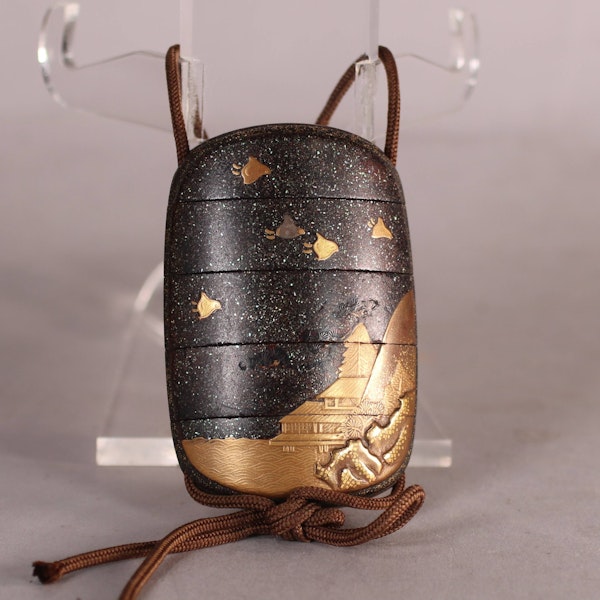Japanese four-case lacquer inro, 19th century
Japanese four-case lacquer inro, 19th century
POA
Description
Japanese four-case lacquer inro, 19th century, with inlaid decoration against a maki-e background depicting a mountainous landscape with a lakeside pagoda and flock of chidori (千鳥, plovers) in flight above.
Condition: Small flake to top, some very small nibbles to the interior rims of cases which do not detract from overall appearance
Notes: In ornithological terms, ‘chidori’ refers generally to a variety of small plovers, including the little ringed plover (コチドリ), the long-billed plover(イカルチドリ)and the Kentish plover (シロチドリ. There are many similarities between the different types; they all have large heads with beady eyes and short beaks, live in marshland or river habitats, and fly in flocks. In Japanese culture, a ‘chidori’ is an auspicious symbol because the distinctive ‘chiyo chiyo’ cry from which its name derives is a homonym for 千代 (chiyo, thousand years/forever). The symbol has been a popular literary, artistic and decorative motif in Japan since at least the Nara period, and the ‘hama chidori’ (plovers near the shore) pattern has adorned textiles, lacquerware and ceramics for hundreds of years. It featured in the ‘kokinshu’ (collection of poems ancient and modern), a Heian period anthology of traditional Japanese poetry which includes the following waka poem connecting chidori with longevity:
しほの山差出の磯にすむ千鳥君が御代をば八千代とぞなく
The plovers on the jutting crags beneath briny Shio Mountain cry out ‘May the years of your life number eight thousand or more’
(7:345 trans. Laurel Rasplica Rodd)
A later poem, by Kobayashi Issa (1763-1827) captures the sight of a flock of chidori suddenly rising:
汐浜を反故にして飛ぶ鵆かな
After creasing and crumpling the salt farm plovers fly away (1:716 trans. Makoto Ueda)
In this case, the ‘hama chidori’ design is inlaid into the maki-e lacquer of a tiered ‘inro’. These small, highly portable boxes have been used by Japanese men since the Muromachi period (1392-1573) during which they were imported from China. They were highly practical – as traditional Japanese garments did not have pockets, they were used to hold necessary everyday items, such as ink, seals or medicine. However, from the mid-Edo period, they became popular as fashionable accessories: suspended from the sash of a kimono by a silk cord and toggle (netsuke), these small boxes allowed wearers to express their taste and wealth, through innovative designs or traditional motifs, skilled craftsmanship and luxurious materials. Lacquer was a popular choice, and was frequently inlaid with nacre, ivory or foil metals.
| item details | |
|---|---|
| Material and Technique | Inlaid lacquer |
| Origin | Japanese |
| Period | 19th Century |
| Dimensions | Height 7.5cm. (3in.) |
Product REF: V29








